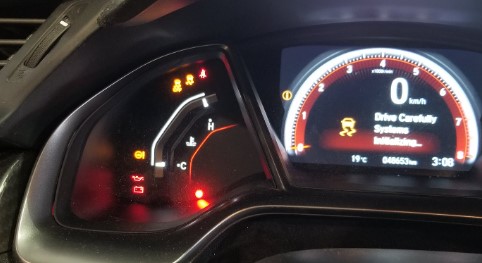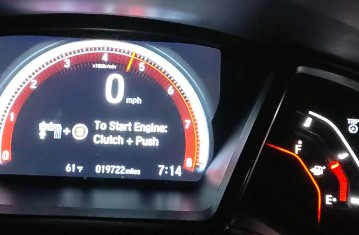The Honda Civic brake system warning light is a light that comes on when there is an issue with the vehicle’s braking system. If this light comes on, it means there is a problem with how the brakes are functioning and that the driver should take the car to a mechanic to have it checked out. This warning light is important because brakes are one of a vehicle’s most important safety features. If they are not working properly, it could lead to an accident. If you see this light come on in your Honda Civic, do not ignore it. Take the car to a mechanic as soon as possible so that they can diagnose and fix the problem.
Recommended article: 2006 Honda Pilot Triangle Warning Light Reset
What Does the Honda Civic Brake System Warning Light Mean?

When the Honda Civic brake system warning light comes on, it means that there is a problem with the vehicle’s braking system. There are several possible causes for this warning light to come on, including:
- A problem with the brake fluid level
- A problem with the brakes themselves
- A problem with the antilock braking system (ABS)
If you see the Honda Civic brake system warning light come on, it’s important to take action immediately. Depending on the severity of the problem, you may need to have your vehicle towed to a nearby service center or dealership. Sometimes, it may be safe to continue driving while taking extra caution, but you should consult a professional if unsure.
See also: Electric Power Steering System Warning Light
How to Respond When the Brake System Warning Light Comes On

When the brake system warning light comes on in your Honda Civic, it’s important to take action immediately. The warning light is an indication that there is a problem with the braking system and it needs to be checked out by a qualified mechanic as soon as possible.
If you’re driving when the warning light comes on, pull to a safe location and turn off the engine. It’s unsafe to go with a problem with the braking system, so you’ll need to have your car towed to a nearby service center.
🎯Suggested article: Honda Element Years To Avoid
Once at the service center, a qualified technician will hook up a diagnostic machine to see what exactly is wrong with the brakes. They may need to replace worn pads or discs, bleed the brakes, or adjust the parking brake. In some cases, more serious repairs may be required.
It’s important to fix any problems with your brakes immediately, as they are essential for safety while driving. Ignoring the warning light can lead to further damage to the braking system, which can be expensive to repair.
Suggested article: Prius Hybrid System Warning Light
What to Do If the Brake System Warning Light Is Flashing

If the brake system warning light is flashing, it indicates a problem with the braking system. The first thing to do is to check the brake fluid level. If it is low, add more fluid. If the group is okay, have the brakes checked by a qualified mechanic as soon as possible.
Read also: Service Stop Start System Warning Light
What to Do If the Brake System Warning Light Is On but There Is No Power
If the brake system warning light is on, but there is no power, you should check the fuse box first. If the fuse is blown, replace it with a new one. If the fuse is not blown, check the brake light switch. If the switch is defective, it will need to be replaced.
If you see the Honda Civic brake system warning light come on, don’t panic. It’s likely just a sign that you must replace your brake pads. However, if strange noises or braking problems accompany the light, it could be a more serious issue, and you should have your car checked out by a mechanic as soon as possible. In any case, paying attention to your car’s warning lights is always a good idea to help keep yourself safe.
FAQs About Honda Civic Brake System Warning Light
What does the brake system mean on a Honda Civic?
The brake system light is an indicator of something potentially wrong with your brakes. When illuminated, it may mean that the brake fluid level is low or that the Antilock Brake System (ABS) could be malfunctioning. The Traction Control/Electronic Stability Program (ESP) light indicates that your vehicle’s electronic stability system is being used to maintain control and traction on slippery surfaces. It is important to take notice of these indicators as they can help you diagnose any potential issues before they become serious problems.
How does the Honda Civic brake hold work?
A warning light in a Honda vehicle may indicate an issue with the brake system or low brake fluid. To address this problem, one should first ensure their parking brake is not currently engaged and carefully drive to a certified Honda service center. Here, they can have their vehicle checked out by a professional technician who can help identify and resolve any issues.
What should you do if the brake system warning light comes on the Honda Civic?
If the warning light illuminates a Honda vehicle, it may indicate an issue with the brake system or low brake fluid levels. It’s important to ensure that your parking brake is not currently engaged and then drive carefully to a Honda-certified service center for professional diagnosis and repair of these issues.
Why is my car saying brake system problem?
When a brake warning light is illuminated, it is typically an indication that the parking brake has been engaged, or there may be a problem with the brakes that necessitates further examination. The meaning of this warning can vary. Therefore, seeking assistance from a brake specialist for proper diagnosis is highly recommended.
What 2 reasons would cause your brake system warning light to come on?
One may notice that the brake light is illuminated while driving. This indicator serves as a notification that there may be low brake fluid levels, the emergency brake has been engaged, issues within the ABS unit are present, or sensor malfunctions have occurred. It is important to address this warning promptly to ensure the proper functioning and safety of one’s vehicle. Neglecting to do so can potentially lead to further damage and unsafe driving conditions. Seeking professional assistance for diagnosis and repairs is recommended in such situations.

